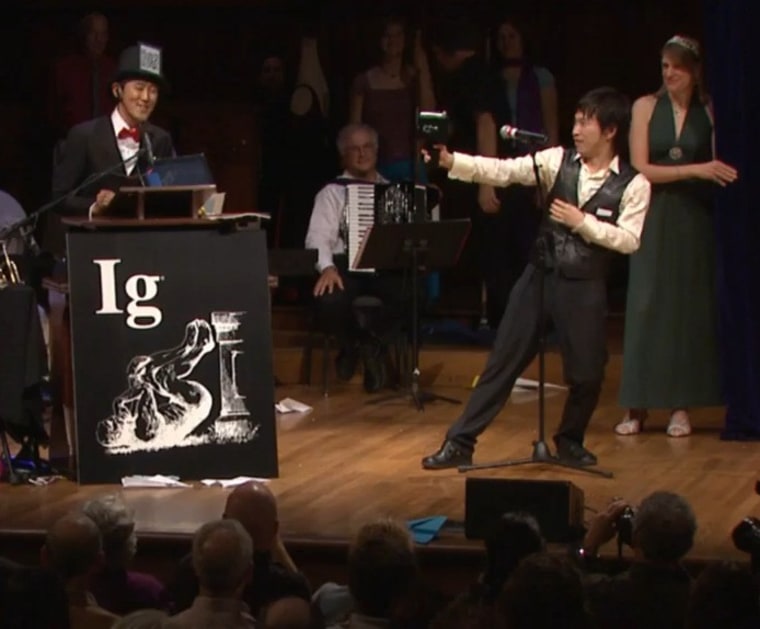For anyone who's ever been tired of listening to someone drone on and on and on, two Japanese researchers have the answer.
The SpeechJammer, a device that disrupts a person's speech by repeating his or her own voice at a delay of a few hundred milliseconds, was named Thursday as a 2012 winner of the Ig Nobel prize — an award sponsored by the Annals of Improbable Research magazine for weird and humorous scientific discoveries.
The echo effect of the device is just annoying enough to get someone to sputter and stop.
Actually, the device created by Kazutaka Kurihara and Koji Tsukada is meant to help public speakers by alerting them if they are speaking too quickly or have taken up more than their allotted time.
"This technology ... could also be useful to ensure speakers in a meeting take turns appropriately, when a particular participant continues to speak, depriving others of the opportunity to make their fair contribution," said Kurihara, of the National Institute of Advanced Industrial Science and Technology in Japan.
Still, winning an Ig Nobel in acoustics for the device's other more dubious purpose is cool too.
"Winning an Ig Nobel has been my dream as a mad scientist," he said.
As usual, the ersatz Nobels were handed out by real Nobel laureates, including 2007 economics winner Eric Maskin, who was also the prize in the "Win a Date with a Nobel Laureate" contest.
A plenitude of prizes
Other winners feted Thursday at Harvard University's opulent Sanders Theatre included Dutch researchers who won the psychology prize for studying why leaning to the left makes the Eiffel Tower look smaller; four Americans who took the neuroscience prize for demonstrating that sophisticated equipment can detect brain activity in dead fish; a British-American team that won the physics prize for explaining how and why ponytails bounce; and the U.S. General Accountability Office, which won the literature prize for a report about reports.
Igor Petrov of Russia's SKN Co. won the peace prize for developing a method to convert old Russian ammunition into new diamonds. Tiny, tiny diamonds.
"Ladies, if you want diamonds, come see me after the show," Petrov told the crowd at Harvard. "But have your own ammunition, please."
Rouslan Krechetnikov, an engineering professor at the University of California Santa Barbara, and graduate student Hans Meyer took home the fluid dynamics prize for research into the sloshing that goes on in coffee cup as it's carried.
Like many projects that have won Ig Nobels in the past, it started in a casual conversation based on everyday observations. Krechetnikov and Meyer were taking a coffee break at a conference last year when they watched as others milled around trying to prevent staining their clothes.
Why coffee spills
The science of sloshing liquids has been studied before — in rocketry, for example, shifting weight can destabilize a missile or rocket — but no one's ever really studied coffee as it splashes around, Krechetnikov said.
"It is one of those cases where we were interested in explaining the phenomena, but not changing it," he said.
The reason coffee spills? A person's walking speed, their mental focus and, surprisingly enough, noise.
Are there practical applications? You could design a better coffee cup by using what Krechetnikov calls "a series of annular ring baffles arranged around the inner wall of the container to achieve sloshing suppression," although those solutions are impractical.
"We just wanted to satisfy our curiosity and, given the results, to share what we learned with the scientific community through peer-reviewed literature," he said.
The 22nd annual Ig Nobels ceremony, with the theme "The Universe," featured the usual doses of zaniness, including the traditional launching of hundreds of paper airplanes and the world premiere of an opera entitled "The Intelligent Designer and the Universe," about an insane wealthy man who bequeaths his fortune to have someone design a beautiful dress for the universe.
"Personally, this goes along with my view of science," Krechetnikov said. "There should be a fun side to it."
The 2012 Ig Nobel references:
- Psychology Prize: Anita Eerland, Tulion Guadalupe and Rolf Zwaan for their study "Leaning to the Left Makes the Eiffel Tower Seem Smaller."
- Peace Prize: SKN Co. for converting old Russian ammunition into new diamonds.
- Acoustics Prize: Kazutaka Kurihara and Koji Tsukada for creating the SpeechJammer — a machine that disrups a person's speech, by making them hear their own spoken words at a very slight delay.
- Neuroscience Prize: Craig Bennett, Abigail Baird, Michael Miller and George Wolford, for demonstrating that brain researchers can use complicated instruments and simple statistics to see brain activity anywhere — even in a dead salmon.
- Chemistry Prize: Johan Pettersson for solving the puzzle of why, in certain houses in the town of Anderslöv, Sweden, people's hair
This report was supplemented by NBC News.
